
Economics_-_New_Ways_of_Thinking
.pdf
Don’t Fall for an Old Scam
One day you receive a letter in the mail. The letter is from
an investment advisor who says that he can predict what will be good investments in the near future.
The Setup
At this point, like most people would be, you are skeptical. Having anticipated your skepticism, the investment advisor goes on to say in his letter that he is going to make a prediction about next week’s price of gold. He predicts that it will rise. It costs you nothing to wait to see if the price of gold rises, so you do.
Next week, the price of gold rises. Soon after, you get another letter from the investment advisor. He reminds you that he wrote you last week and predicted a rise in the price of gold. He reminds you that
things happened as he said they would. Just to prove to you, once again, that he can predict increases and decreases in the price of gold, he tells you that next week the price of gold will fall. Sure enough, the price of gold does fall the next week.
Again, you get a letter from the advisor. Again he reminds you that he correctly predicted the change in the price of gold in two consecutive weeks. He makes a third prediction. He predicts that next week the price of gold will rise again. Sure enough, he is right a third time.
The Hook
The final letter you get from the advisor reminds you that he predicted the change in gold in three consecutive weeks. He asks whether you are convinced that he can pre-
dict what will and will not be good investments. He also asks you for $1,000, after which he promises to send you a weekly update of his investment advice. He says that if you only follow his “crystal-ball advice” you can turn a little money into a lot.
Don’t Be Fooled
Now if you are thinking that you should go along and send in the $1,000, think again. What the investment advisor has just done is make a promise to you that he cannot possibly keep. He can’t really predict the good investments time after time.
But he’s done it, you say. You saw him do it with your own two eyes. He didn’t just say he could predict the change in the price of gold, he did it.
Be skeptical of any get-rich offers you receive in the mail. If it sounds too good to be true, it probably is.
204 Chapter 8 Competition and Markets
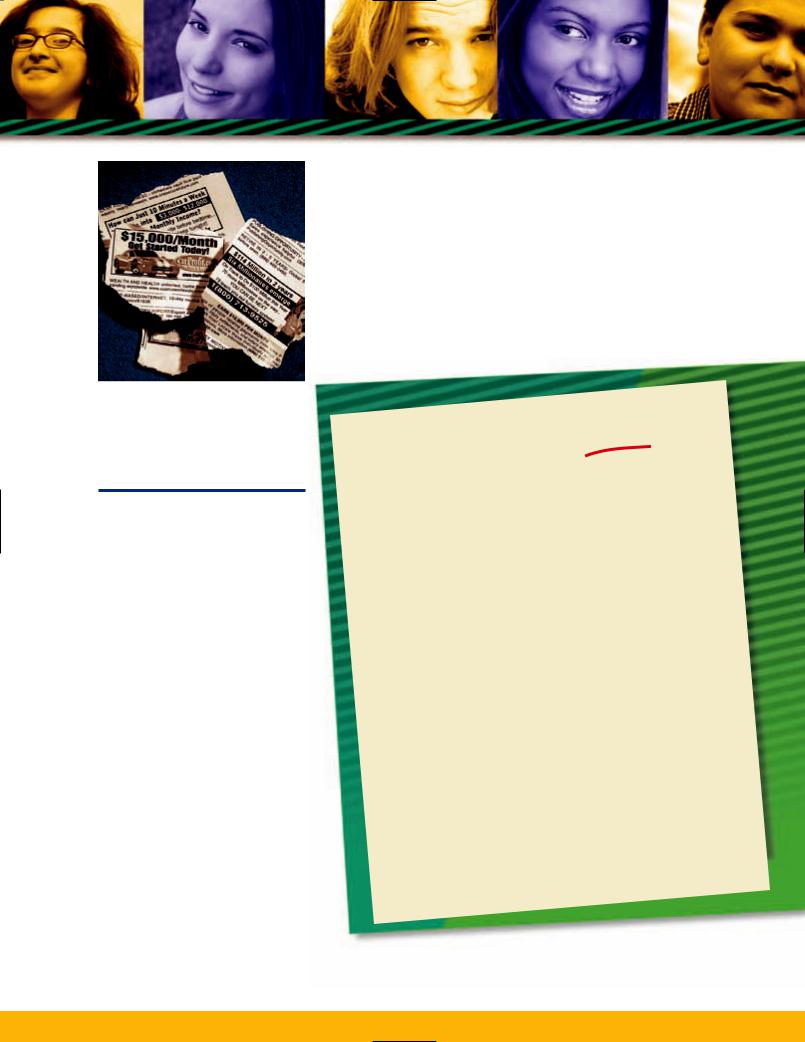
gold. To the other half he predicted a rise in the price of gold. When the price of gold rose, he then wrote the people who got the “price-is-going- up” letter—one of whom was you— and told you how he had predicted things correctly three times in a row. Then came the request for money— he urged you to pay him $1,000 for his investment advice.
So, you see, the investment advisor never really predicted anything. He just wrote a lot of letters, predicting a higher price of gold in half of the letters and predicting a lower price of gold in the other half. To the people who received the “correct prediction,” he wrote again. He wasn’t predicting the future, he was covering all bases. He was running a scam.
Even reputable newspapers and magazines contain ads for questionable business ventures. Investigate the company before giving them your money if you have any doubts.
How It Works
Here is how he did it. Before you got your first letter from the investment advisor, he wrote 10,000 letters. Half of the letters predicted an increase in the price of gold next week, and half predicted a decrease. The investment advisor kept a record of the people to whom he sent each letter. When the price of gold went up the next week, he then wrote the people who got the “price-is-going- up” letter again. He did not write to the “price-going-down” people.
In the second round of letters he predicted a rise in price to half the people and a decline in price to the other half. When the price of gold went down, he then wrote the people who got the “price-is-going- down” letter again, but did not write again to the “price-going-up” people.
He repeated this process one more time. To half of the people receiving the third round of letters he predicted another fall in the price of
|
|
|
|
|
|
|
|
|
|
|
|
|
|
Economics |
Action |
Plan |
|
|
|
||||||||||||||||||||||||||||||||||
My Personal |
|
|
|
|
|
|
|
|
|
|
|
||||||||||||||||||||||||||||||||||||||||||
|
|
|
|
|
|
|
|
|
|
and some |
|
|
|
||||||||||||||||||||||||||||||||||||||||
|
|
|
|
you may want |
|
to consider |
|
|
|
||||||||||||||||||||||||||||||||||||||||||||
|
|
|
|
|
|
|
|
|
|
|
|
|
|
|
|
|
|
|
|
|
|
||||||||||||||||||||||||||||||||
|
|
|
are some |
points |
|
|
|
|
|
|
|
|
|
|
|
|
|
||||||||||||||||||||||||||||||||||||
Here |
|
|
|
|
|
|
|
|
|
|
|
|
|
|
|
|
|
|
|
|
|
|
|
|
|||||||||||||||||||||||||||||
|
|
to put into |
practice: |
|
|
|
|
|
|
|
|
|
|
|
|
|
|
|
|||||||||||||||||||||||||||||||||||
|
|
|
|
|
want |
|
|
|
|
|
|
|
|
|
|
|
|
|
|
|
|||||||||||||||||||||||||||||||||
|
you might |
|
|
|
|
|
|
|
|
|
|
|
|
|
|
|
|||||||||||||||||||||||||||||||||||||
guidelines |
|
|
|
|
|
|
|
|
|
to be true,” |
it |
|
|
|
|
||||||||||||||||||||||||||||||||||||||
|
|
|
|
|
|
|
|
|
|
|
|
|
|
|
|
|
|
|
|
|
|
||||||||||||||||||||||||||||||||
|
|
|
|
|
|
|
|
|
|
|
|
|
|
“too good |
|
|
|
|
|||||||||||||||||||||||||||||||||||
|
|
|
|
|
|
|
|
|
|
|
|
|
|
|
|
|
|
|
looks |
|
|
|
|
||||||||||||||||||||||||||||||
|
|
|
|
|
|
|
|
something |
|
|
|
|
|
|
|||||||||||||||||||||||||||||||||||||||
|
|
Often, |
when |
|
|
|
|
|
|
|
|
|
|
|
|
|
|
|
|
||||||||||||||||||||||||||||||||||
|
|
|
|
|
|
|
|
|
|
|
|
|
|
|
|
|
|
|
|
|
|
|
|
|
|
|
|||||||||||||||||||||||||||
1. |
|
|
|
|
|
|
|
|
|
|
|
|
|
|
|
|
|
|
|
|
|
|
|
|
|
|
|
|
|
|
|
||||||||||||||||||||||
|
|
|
|
|
|
|
|
|
|
|
|
|
|
|
|
|
|
|
|
|
|
|
|
|
|
|
|
|
|
|
|
|
|
|
|
|
|
|
|
|
|
||||||||||||
|
|
|
|
|
|
. |
|
|
|
|
|
|
|
|
|
|
|
|
|
|
|
|
|
|
|
|
|
|
|
|
|
|
|
|
|
|
|
|
|
|
|
|
|
|
|
|
|
|
|
|
|
||
|
|
|
|
|
|
|
|
|
|
|
|
|
|
|
|
|
|
|
|
|
|
|
|
|
|
|
|
|
|
|
|
|
|
|
|
|
|
|
|
|
|
|
|
|
|
|
|
|
|
|
|
|
|
|
|
isn’t |
true |
|
|
|
|
|
|
|
|
|
|
|
|
|
|
|
|
|
|
|
|
|
|
|
|
|
|
|
|
|
|
|
|
|
|
|
|
|
|
|
|
|
|
- |
|
||||||
|
|
|
|
|
|
|
|
|
|
|
|
|
|
|
to question |
and investigate |
further |
any |
|
|
|||||||||||||||||||||||||||||||||
|
|
|
|
|
|
|
|
|
|
|
|
|
|
|
|
|
|
|
|
|
|
||||||||||||||||||||||||||||||||
|
I promise myself |
|
|
|
|
|
|
|
|
|
|
|
|
|
|
||||||||||||||||||||||||||||||||||||||
|
|
|
|
|
|
|
|
.” |
|
|
|
|
|
|
|
|
|
|
|
|
|
|
|
|
|
|
|
||||||||||||||||||||||||||
|
|
|
|
|
|
|
|
|
|
|
|
|
|
|
|
|
|
|
|
|
|
|
|
|
|
|
|
|
|
|
|
|
|
|
|
|
|
||||||||||||||||
|
thing |
that seems |
|
“too good |
to be true |
|
|
|
|
|
|
|
|
|
|
|
|
|
|
|
|
|
|
|
|
||||||||||||||||||||||||||||
|
|
|
|
|
|
|
|
|
|
|
|
|
|
|
|
|
|
|
|
|
|
|
|
|
|
|
|
|
|
|
|
||||||||||||||||||||||
|
|
|
|
|
|
|
|
|
|
|
|
|
|
|
|
|
|
|
|
|
|
|
|
|
as easy |
as some |
|||||||||||||||||||||||||||
|
|
|
|
|
|
|
|
|
|
|
|
|
|
|
|
|
|
|
|
|
|
|
|
|
|
|
|
|
|
|
|
|
|
|
|
||||||||||||||||||
|
|
|
|
|
|
|
|
|
|
|
|
|
|
|
the right investment |
were |
|||||||||||||||||||||||||||||||||||||
|
|
|
|
|
|
|
|
|
|
|
|
|
|
|
|
|
|
|
|
|
|
- |
|||||||||||||||||||||||||||||||
|
|
|
If predicting |
|
|
|
|
|
|
|
|
|
|
|
|
|
|
||||||||||||||||||||||||||||||||||||
|
|
|
|
|
|
|
|
|
|
|
|
|
|
|
|
|
|
|
|
|
|||||||||||||||||||||||||||||||||
|
2. |
|
|
|
|
|
|
|
|
|
|
|
|
should |
easily |
be multimillion |
|||||||||||||||||||||||||||||||||||||
|
|
people say |
|
it is, then they |
|
. Why do they |
need to |
||||||||||||||||||||||||||||||||||||||||||||||
|
|
|
|
|
|
|
|
|
|
|
|
||||||||||||||||||||||||||||||||||||||||||
|
|
|
aires |
from |
their |
own investments |
|
|
|
|
|
|
|
|
|
|
|
|
|
|
|
|
|
|
|||||||||||||||||||||||||||||
|
|
|
|
|
|
|
|
|
advice |
business? |
|
|
|
|
|
|
|
|
|
|
|
|
|
||||||||||||||||||||||||||||||
|
|
|
|
investment |
|
|
|
|
|
|
|
|
|
|
|
|
|
||||||||||||||||||||||||||||||||||||
|
|
|
|
|
|
|
|
|
|
|
|
|
|
|
|
|
|
|
|
|
|
|
|||||||||||||||||||||||||||||||
|
|
|
go into the |
|
|
|
|
|
|
|
|
|
|
|
try |
||||||||||||||||||||||||||||||||||||||
|
|
|
|
|
|
|
|
|
|
|
|
|
|
|
|
|
I will |
||||||||||||||||||||||||||||||||||||
|
|
|
|
|
|
|
|
|
|
|
|
|
|
|
|
situation, |
|||||||||||||||||||||||||||||||||||||
|
|
|
|
|
|
|
|
|
|
good |
to be true” |
|
|||||||||||||||||||||||||||||||||||||||||
|
|
|
|
|
|
|
|
|
|
|
|
|
|
|
|
|
a |
“too |
|
|
. |
||||||||||||||||||||||||||||||||
|
|
|
|
|
|
|
|
|
|
|
|
|
|
|
|
|
|
|
|
|
|
|
|
|
|
||||||||||||||||||||||||||||
|
|
|
|
|
|
|
|
|
|
|
|
|
|
|
|
|
|
|
|
|
|
|
|
|
|
|
|
|
|
|
|
|
|||||||||||||||||||||
|
|
|
|
|
|
|
|
|
|
|
|
|
|
|
|
|
|
|
|
|
|
|
|
|
|
|
|
|
|
|
|
|
|
|
|
|
|
|
|
|
|
|
|||||||||||
|
|
When |
I confront |
|
|
|
|
|
|
of the person |
|
making the |
offer |
||||||||||||||||||||||||||||||||||||||||
|
|
|
|
|
|
|
|
|
|
the motives |
|
|
|
|
|
|
|
|
|
|
|
|
|
|
|
|
|
||||||||||||||||||||||||||
|
|
to determine |
|
|
|
|
|
|
|
|
|
|
|
|
|
|
|
|
|
|
|
“to make |
|
|
|
||||||||||||||||||||||||||||
|
|
|
|
|
|
|
|
|
|
|
|
|
that I’m guaranteed |
|
|
|
|
||||||||||||||||||||||||||||||||||||
|
|
|
|
|
|
|
|
|
|
|
|
|
|
|
|
tells me |
|
|
|
|
|||||||||||||||||||||||||||||||||
|
|
|
|
If someone |
|
|
|
I will ask |
|||||||||||||||||||||||||||||||||||||||||||||
|
|
3. |
|
|
|
|
|
person’s |
advice, |
||||||||||||||||||||||||||||||||||||||||||||
|
|
money” |
if I just take |
that |
|
|
to refund |
my |
|
||||||||||||||||||||||||||||||||||||||||||||
|
|
|
|
|
|
is willing |
|
||||||||||||||||||||||||||||||||||||||||||||||
|
|
|
|
|
|
|
|
|
|
not that person |
|
|
|
|
|
||||||||||||||||||||||||||||||||||||||
|
|
|
|
whether or |
|
|
|
|
. |
|
|
|
|
|
|
|
|
|
|
||||||||||||||||||||||||||||||||||
|
|
|
|
|
|
|
|
|
|
|
|
|
|
|
|
|
|
|
|
|
|
|
|
|
|
|
|||||||||||||||||||||||||||
|
|
|
|
|
|
|
|
|
|
|
|
|
|
|
|
|
|
|
|
|
|
|
|
|
|
|
|
|
|
|
|
|
|
|
|
|
|
|
|
||||||||||||||
|
|
|
|
money |
if the investment |
isn’t |
successful |
|
|
|
|
|
|
|
|
|
|
||||||||||||||||||||||||||||||||||||
|
|
|
|
|
|
|
|
|
|
|
|
|
|
|
|
|
|
|
|
|
I will |
||||||||||||||||||||||||||||||||
|
|
|
|
|
|
|
|
|
|
|
|
aren’t |
possible, |
||||||||||||||||||||||||||||||||||||||||
|
|
|
|
|
|
|
|
|
|
|
|
|
says that refunds |
||||||||||||||||||||||||||||||||||||||||
|
|
|
When the person |
|
|
|
.” |
||||||||||||||||||||||||||||||||||||||||||||||
|
|
|
|
|
|
|
|
|
|
|
|
|
|
|
|||||||||||||||||||||||||||||||||||||||
|
|
|
|
|
|
|
|
|
|
|
|
|
|
|
|
|
|
|
|
||||||||||||||||||||||||||||||||||
|
|
|
|
|
|
that the advice |
was “guaranteed |
||||||||||||||||||||||||||||||||||||||||||||||
|
|
|
remind |
the “advisor” |
|
|
|
|
|
|
|
|
|
|
|
|
|
|
|
|
|
||||||||||||||||||||||||||||||||
|
|
|
|
|
|
|
|
|
|
|
|
|
|
|
|
|
|
|
|
|
|
|
|
|
|
|
|
|
|
|
|
|
|
|
|||||||||||||||||||
|
|
|
|
|
|
|
|
|
|
|
|
|
|
|
|
|
|
|
|
|
|
|
|
|
|
|
|
|
|
|
|
|
|
|
|
|
|
|
|
|
|
|
|
|
|
|
|
|
|||||
Chapter 8 Competition and Markets 205

A Monopolistic
Competitive
Market
Focus Questions
What are the characteristics of monopolistic competition?
What are some examples of monopolistic competition?
Are monopolistic competitors price takers or price searchers?
How do monopolistic competitors answer questions about how much to produce and what price to charge?
What are some ways in which the products of monopolistic competitors differ?
Key Term
monopolistic competitive market
monopolistic competitive market
A market structure characterized by (1) many buyers and many sellers,
(2) the production and sale of slightly differentiated products, and (3) easy entry into and easy exit from the market.
Characteristics of a
Monopolistic Competitive
Market
Between perfect competition at one extreme and monopoly at the other, there are two types of markets: monopolistic competitive and oligopolistic. In this section you will learn about monopolistic competition. In the next section we will examine oligopolies.
The three characteristics of a monopolistic competitive market are as follows:
1.The market includes many buyers and many sellers.
2.Firms produce and sell slightly differentiated products.
3.Firms have easy entry into and exit out of the market.
Notice that two of the characteristics (the first and third) are the same as found in a perfectly competitive market (a perfectly competitive market has many buyers and sellers and easy entry and exit). One characteristic (the second characteristic) is not found in either a perfectly competitive or monopolistic market.
Monopolistic Competitive
Firms Are Price Searchers
Firms in a monopolistic competitive market are price searchers. Why do we consider them price searchers? Because they sell a slightly differentiated product.
Suppose firm A is a monopolistic competitive firm or seller. It is currently producing and selling good A at $40 per unit. At this price, it sells 1,000 units a week. If it raises its price to $45, it is likely to still sell some of its product (say, 700 units), because what it sells is not identical to any other product in the market. In other words, consumers will not be able to shift wholly from buying good A to buying an identical good; good A is slightly different from all other goods.
 In many cities and towns, you will find a good number of Italian and Mexican restaurants. One restaurant that serves Italian-style food may be similar to, but not identical with, another restaurant that serves Italian-style food. These restaurants operate in a monopolistic competitive market.
In many cities and towns, you will find a good number of Italian and Mexican restaurants. One restaurant that serves Italian-style food may be similar to, but not identical with, another restaurant that serves Italian-style food. These restaurants operate in a monopolistic competitive market.
206 Chapter 8 Competition and Markets
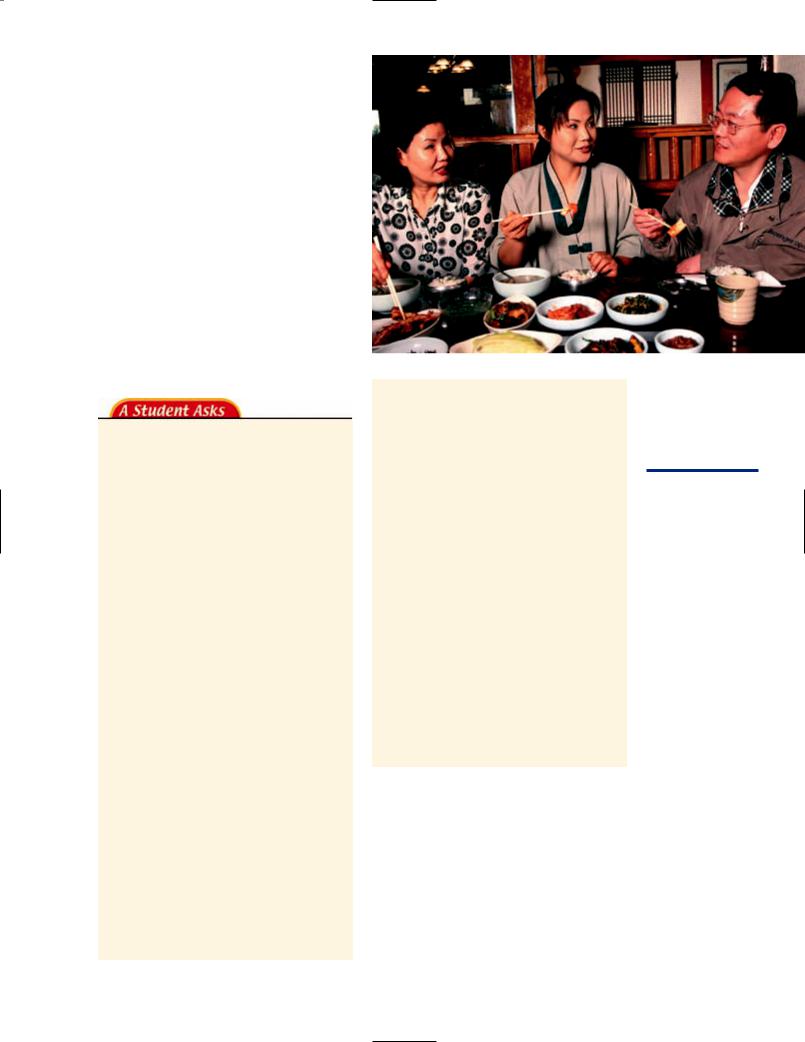
What Do Monopolistic
Competitive Firms Do?
Like perfectly competitive firms and monopoly firms, monopolistic competitive firms have to answer two questions: (1) How much do we produce? and (2) What price do we charge? They answer the first question the same way every firm answers it: they produce the quantity of output at which marginal revenue equals marginal cost. They answer the second question the same way monopoly sellers answer it: by searching for the highest price per unit at which they can sell their entire output. If they produce 10,000 units of their good, they search for the highest per-unit price at which they can sell all 10,000 units.
QUESTION: What use is it to me to know that one seller (say, a wheat farmer) operates in a perfectly competitive market and another seller (a restaurant) operates in a monopolistic competitive market?
ANSWER: What this information helps you understand is why the prices you pay are what they are. Suppose a number of sellers are selling a particular good for the same price. (Every seller is charging $100.) When some people see all the same prices, they sometimes jump to the conclusion that the sellers agreed among themselves to sell the good for the same price. In other words, people think they colluded on price. Of course, another explanation that you learned from our discussion of a perfectly competitive market is that all sellers sometimes sell the good for the same price because they have no other choice. In other words, no collusion is involved at all. It’s just that the sellers are operating in a perfectly competitive market.
Suppose you wonder why some medicines are priced as high as they are. Some of the high price has to do with the patents that pharmaceutical companies
hold—patents that hold other sellers out of the market (for a period of time). Or suppose you learn that in your town only one cable company has the right to provide cable TV services. Would you have known how this type of monopoly would affect your monthly cable bill? Now you know that limiting entry to a market (for good reasons or bad reasons) always results in higher prices than would have existed had entry not been limited.
We do not expect that as the years pass, you will go around in your daily life pointing out which companies are perfectly competitive companies, and which companies are monopolists, and so on. That is not the reason for learning this material. The reason is to understand “how things work” in a part of the world that you might not have understood before.
Do you think the owner of this restaurant is a price taker or a price searcher?
How Are Monopolistic
Competitors’ Products
Different?
When we say that one product is slightly different from another product, to what are we referring? When we say that McDonald’s hamburgers are slightly different from Burger King’s hamburgers, for example, the
Section 3 A Monopolistic Competitive Market 207
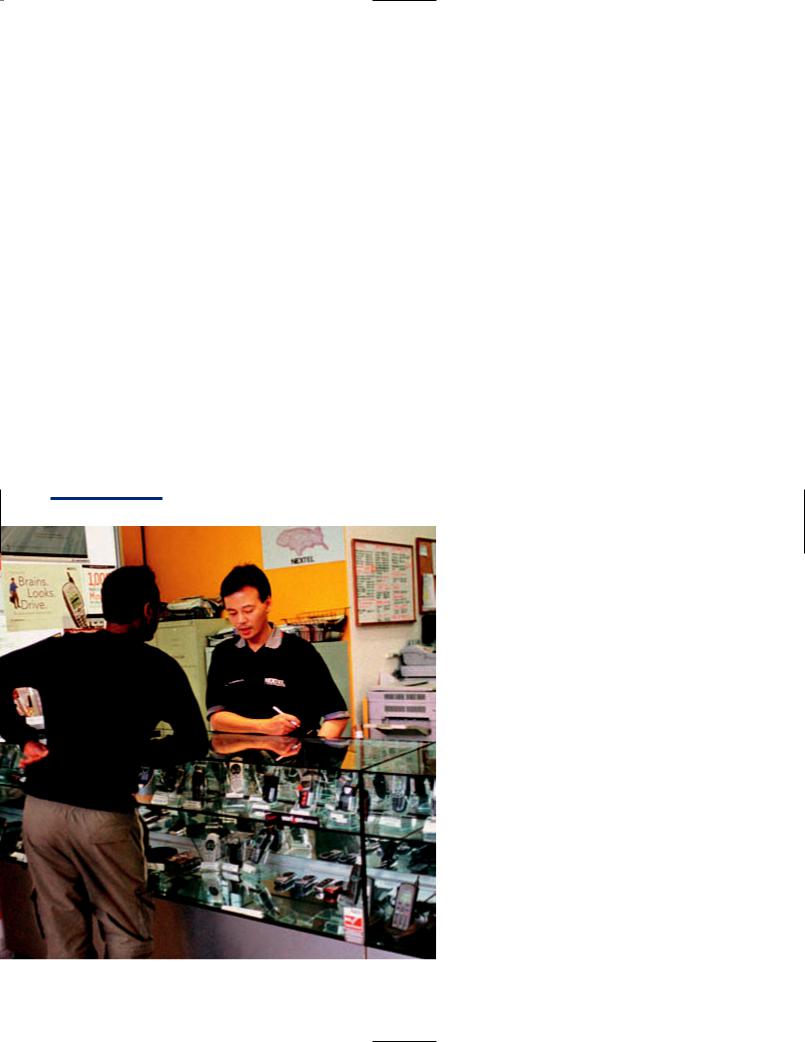
Customers have many different features to choose from when buying a new cell phone. In what ways might the phones differ, in addition to the features of the phone itself?
word different refers to taste and appearance. McDonald’s hamburgers look and taste slightly different (to most people) from Burger King’s hamburgers. Products can differ in other ways, too. For example, consider a particular brand of gasoline sold at a gas station at Third Avenue and Main Street and at a gas station at Ninth Avenue and Main Street. Is the gasoline at the two stations identical? Certainly the physical properties are the same, but the gasoline is sold at different locations, and the locational differences may affect the choices of the buyers of the gasoline. For example, suppose the gas station at Third and Main is in a dangerous neighborhood, and the gas station at Ninth and Main is in a safe neighborhood. Consumers may perceive gas sold in a safe neighborhood as slightly different from gas sold in a dangerous neighborhood. In other words, the location at which a product is sold may be enough to differentiate one physically identical product from another.
Monopolistic competitors’ products, then, can be different in any way that is per-
ceived as different by consumers. If location makes a difference to consumers, then two physically identical products sold at different locations are slightly different products. If different credit terms, sales service, or delivery options make two physically identical products different in the minds of consumers, then they are slightly different products. In short, when it comes to buying products, the physical properties of a product may not be all that matters to consumers. How the product is packaged, where it is purchased, from whom it is purchased, and whether it is delivered may all matter (make a difference) to consumers.
Many Monopolistic
Competitors Would Rather
Be Monopolists
Suppose you own a business that is considered a monopolistic competitive firm. Your business is one of many sellers, you sell a product slightly differentiated from the products of your competitors, and entry into and exit from the industry is easy. Would you rather your business was a monopolist firm instead? Wouldn’t it be better for you to be the only seller of a product than to be one of many sellers?
Most business owners would say it is indeed better to be a monopolist firm than a monopolistic competitive firm, because they believe that as a monopolist they would face less competition. How do monopolistic competitors go about trying to become monopolists?
Some monopolistic competitors use advertising. If a monopolistic competitor can, through advertising, persuade the buying public that its product is more than slightly differentiated from those of its competitors, it stands a better chance of becoming a monopolist. For example, many firms produce men’s and women’s jeans, and many people think the jeans produced by these firms look very much alike. How, then, does any one of the firms differentiate its product from the pack? Some companies add designer labels to their jeans to suggest that they are uniquely desirable.
208 Chapter 8 Competition and Markets

QUESTION: Are you suggesting that it is wrong or uneconomical to buy designer jeans?
ANSWER: Not at all. People may get “utility” or “satisfaction” from wearing designer jeans. It is not the job of the economist to tell consumers how they should get their satisfaction. Sometimes people buy, say, designer clothes because they feel it sets them apart from others, or because their friends are wearing designer clothes, or because they feel better about themselves if they are wearing a particular item with a monogram. We are not saying that any of these preferences are wrong. We are simply pointing out that sellers will sometimes try to differentiate their products (from their competitors’ products) by adding a particular label, or coming up with a particular “motto” (“Just Do It”), and other such things. It is up to the consumer to decide whether the designer label, the motto, or anything else is worth the (sometimes) higher price. It might be a bland world indeed if all shirts were green, all jeans were the same cut, and all MP3 players were the same color.
What Matters Is How Much
Competition a Seller Faces
One of the major differences between sellers in different types of markets is how much competition a seller in each market faces. How much competition a seller faces—much, some, very little, none—prin- cipally depends on two factors: how close to unique a seller’s product is, and how easy it is for new sellers to enter the market.
In a perfectly competitive market, a seller does not produce and sell a unique product at all: it produces and sells a product identical to that of other sellers. This means the seller is in a competitive position. If it raises the price of its product by only one penny over equilibrium price, consumers can turn to other sellers to purchase the identical product. A seller in a perfectly competitive market faces stiff competition from other sellers currently in
o to www.emcp.net/ Gbloomberg.com/ and find
today’s price of gold. Are the sellers of gold price takers or price
searchers? Explain your answer. Next, go to Amazon.com in the United States (www.emcp.net/amazon.com) and in the United Kingdom (www.emcp.net/amazon_uk). Find the price of the most recent Harry Potter book in both pounds and dollars. Next, go to www.emcp.net/currency and find today’s dollar price for a pound. Next, multiply it by the pound price of the Harry Potter book. Is the price of the Harry Potter book in the United States and the United Kingdom the same? On the day we looked, the dollar price of Harry Potter and the Half-Blood Prince was $17.99, and the pound price was £9.99. The dollar price of a pound was $1.8233. Multiplying $1.8223 by 9.99, we get $18.20. In other words, Harry Potter was selling for $17.99 in the United States and for $18.20 in the United Kingdom.
the market, as well as potentially stiff competition from new sellers who may join the market. After all, a perfectly competitive market has easy entry into the market.
Things are somewhat different for the monopolistic competitive seller. This seller does not face as much competition from current sellers, because it produces and sells a product that is slightly different from that of other sellers. A rise in the price of its good will not cause all its customers to leave it and head for its competitors. Still, the monopolistic competitor has the same problem as the perfect competitor when it comes to potential
Why might a jean manufacturer create a designer label for its jeans?
209
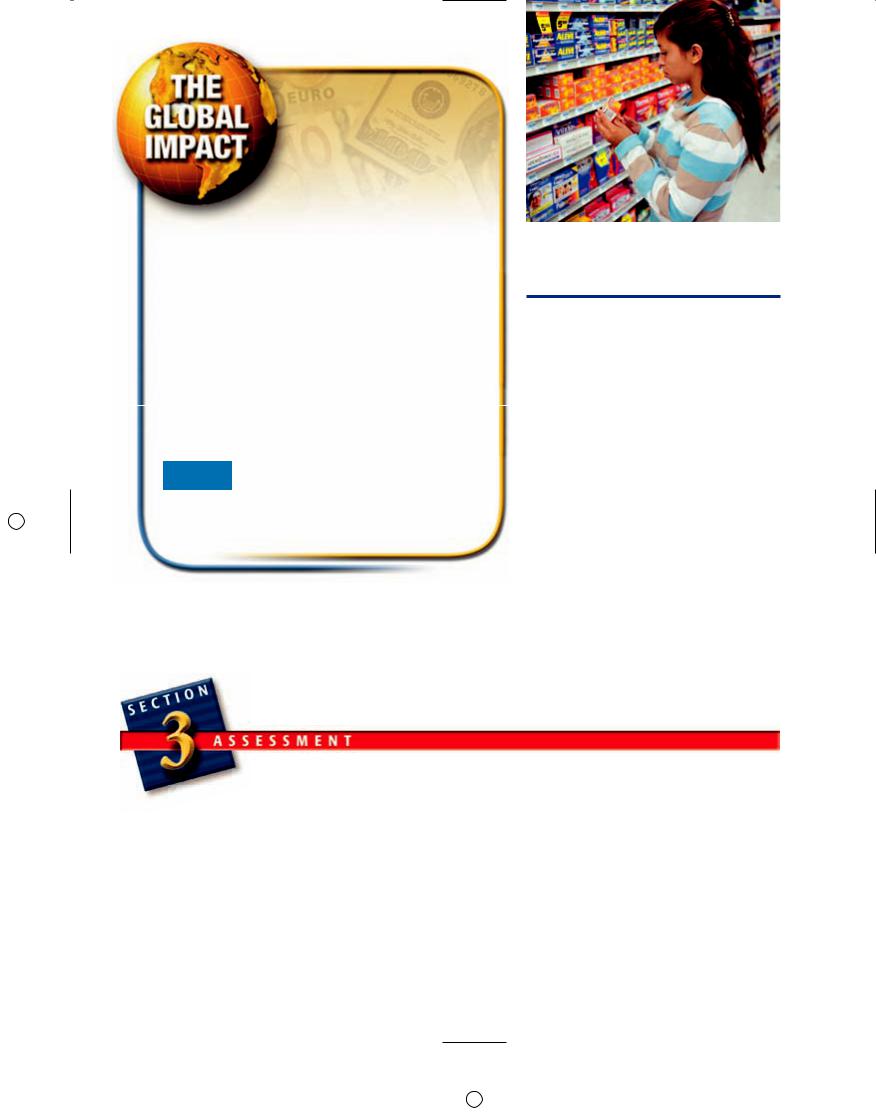
Lower Taxes?
In 2001, a worker in Belgium paid 55 cents in taxes out of every $1 earned. In the same
year, a worker in Ireland paid 25 cents in taxes out of every $1 earned. Going back a few years, in the
late 1990s, several major Swedish companies said they were likely to leave Sweden because taxes were high. Mainly they were talking about taxes on personal income (earned by workers and owners of the companies). In Sweden, in 2001, a worker paid 48 cents in taxes for every $1 earned. Keep in mind that a job activity that requires only a computer screen, a telephone, and a modem can be located anywhere in the world. Today, with lower telecommunication costs, companies and workers find it easier to locate anywhere in the world. They have an increased ability to “vote with their feet,” which means if they don’t like it one place, they can move somewhere else.
Will this increased ability to vote with one’s feet, which is a characteristic of
globalization, cause taxes in many high-tax countries to drop? Might the high-tax country lower its taxes in order to keep companies and workers in the country?
competitors because of easy entry into a monopolistic competitive market, just as in a perfectly competitive market. New sellers can be just around the corner waiting to take away some of a current monopolistic com-
How would you categorize the painkiller market—perfectly competitive, monopoly, or monopolistic competitive? Explain.
How much competition does a monopoly seller face? It faces less competition than either a perfect competitor or a monopolistic competitor. It sells a product that has no close substitutes. Consumers buying from monopoly sellers have fewer options available to them than they do when they buy from perfect competitors or monopolistic competitors. For example, if a monopolistic competitor raises price too high, provides poor service, or lowers quality, many consumers will choose to walk away and buy from the seller’s competition. It’s not that easy to walk away from a monopoly seller, because no sellers sell a close substitute for the monopoly seller’s products. In short, the monopoly seller does not have to be afraid of competition, because it really doesn’t have much. Furthermore, competition is not likely to increase because of barriers to entering the
Reviewing Facts and
Concepts
1.What three conditions characterize a monopolistic competitive market?
2.How might monopolistic competitors’ products be slightly different?
3.A monopolistic competitive market shares some
things with a perfectly |
listic competitor, and a |
competitive market and |
perfect competitor alike? |
some things with a |
Applying Economic |
monopolistic market. |
|
Explain. |
Concepts |
Critical Thinking |
5. Identify an action of a |
real-world monopolistic |
|
4. In what way or ways are a |
competitor that is trying |
monopolist, a monopo- |
to turn itself into a |
|
monopolist. |
210 Chapter 8 Competition and Markets

An Oligopolistic
Market
Focus Questions
What are the characteristics of an oligopolistic market?
What are some examples of an oligopolistic market?
Are sellers in an oligopolistic market price takers or price searchers?
What are cartel agreements?
Key Terms
oligopolistic market cartel agreement price discrimination
Characteristics of an
Oligopolistic Market
The following three conditions characterize an oligopolistic market:
1.It has few sellers.
2.Firms produce and sell either identical or slightly differentiated products.
3.The barriers to entry are significant, which means that entry into the market is difficult.
Exhibit 8-3 lists the conditions that characterize each of the four markets discussed in this chapter.
Oligopolistic Firms Are Price
Searchers
Like monopolistic and monopolistic competitive firms, oligopolistic firms are price searchers. In other words, they have some control over the price they charge. They can raise the price of their good and still sell some of the good they produce (which is not the case for a price taker).
How Much Competition Do
Oligopolists Face?
The last section developed a way to think about sellers in various markets. We think about, or categorize, sellers according to how much competition they face. In turn, how much competition a seller faces depends on how close to unique a seller’s product is and how easy it is for new sellers to enter the market and compete with it. With this information as background, let’s discuss oligopoly.
How close to unique is an oligopolist’s product? According to the conditions that characterize oligopoly, an oligopolist’s product is not unique. Some oligopolists produce an identical good (e.g., steel), and others produce a slightly differentiated product (e.g., cars). We would expect, then, that an oligopolistic seller faces fairly intense competition from current sellers. For example, Ford Motor Company faces stiff competition from General Motors. In the world market for cars, Ford faces extremely stiff competition from Japanese
oligopolistic market
A market structure characterized by (1) few sellers, (2) the production and sale of either identical or slightly differentiated products, and
(3) significant barriers to entry.
Section 4 An Oligopolistic Market 211

E X H I B I T 8-3 Conditions That Characterize
Various Markets
|
Number |
Type of |
Barriers |
Control |
|
of |
|||
Market |
sellers |
product |
to entry |
over price |
Examples of products and services sold in this type of market
Perfectly |
Many |
competitive |
|
Identical |
No barriers |
No control |
Wheat, corn, |
|
|
|
stocks |
Monopolistic |
One |
Unique |
Extremely |
Considerable |
|
|
|
high barriers |
amount of |
|
|
|
|
control |
Monopolistic |
Many |
Slightly |
No barriers |
Yes, but not |
competitive |
|
differentiated |
|
as much as |
|
|
|
|
in monopoly |
Water, electricity, delivery of first-class mail
Clothing, meals at restaurants
Oligopolistic |
Few |
Identical or |
Significantly |
Yes, but not |
Cars, cereal |
|
|
slightly |
high barriers |
as much as |
|
|
|
differentiated |
|
in monopoly |
|
car companies such as Toyota, Nissan, Honda, and Mitsubishi.
Where the oligopolistic seller does not face too much competition is from potential sellers. It is difficult to enter an oligopolistic market, so current oligopolistic sellers are shielded from new sellers to some degree.
QUESTION: I always thought that the more sellers in a given market (for example, the more sellers of, say, computers), the more competition in that market. Now it sounds like there can be quite a bit of competition in a market even with only two or three sellers. Is this statement correct?
ANSWER: Yes. Competition can exist in a market with three sellers and with 300 sellers. For example, think back to the days of only three television networks: ABC, NBC, and CBS. The three networks stiffly competed with each other. Today more competition in the television market exists largely because of cable. Still, the television market experienced competition before cable.
Identifying Oligopolistic
Industries
Economists determine whether a market is oligopolistic by looking at the percentage of sales accounted for by the top four firms in the industry. If only a few firms account for a large percentage of sales, then the market is considered oligopolistic. For example, suppose an industry consists of 10 firms, and the total revenue of the industry is $100 million. The four firms with the highest sales generate $80 million in revenue. In other words, the top four firms account for 80 percent of total revenues in the industry (because $80 million is 80 percent of $100 million), and the industry is dominated by the top four firms. It is an example of an oligopolistic market.
Now consider a real-world example. The U.S. automobile industry is largely made up of General Motors, Ford Motor Company, and Chrysler (or DaimlerChrysler) Corporation. Together, these three firms account for about 90 percent of American-made cars sold in the United States. Other examples of oligopolistic markets include industries that produce cigarettes, tires and inner tubes, breakfast cereals, farm machinery, and soap and detergents.
212 Chapter 8 Competition and Markets
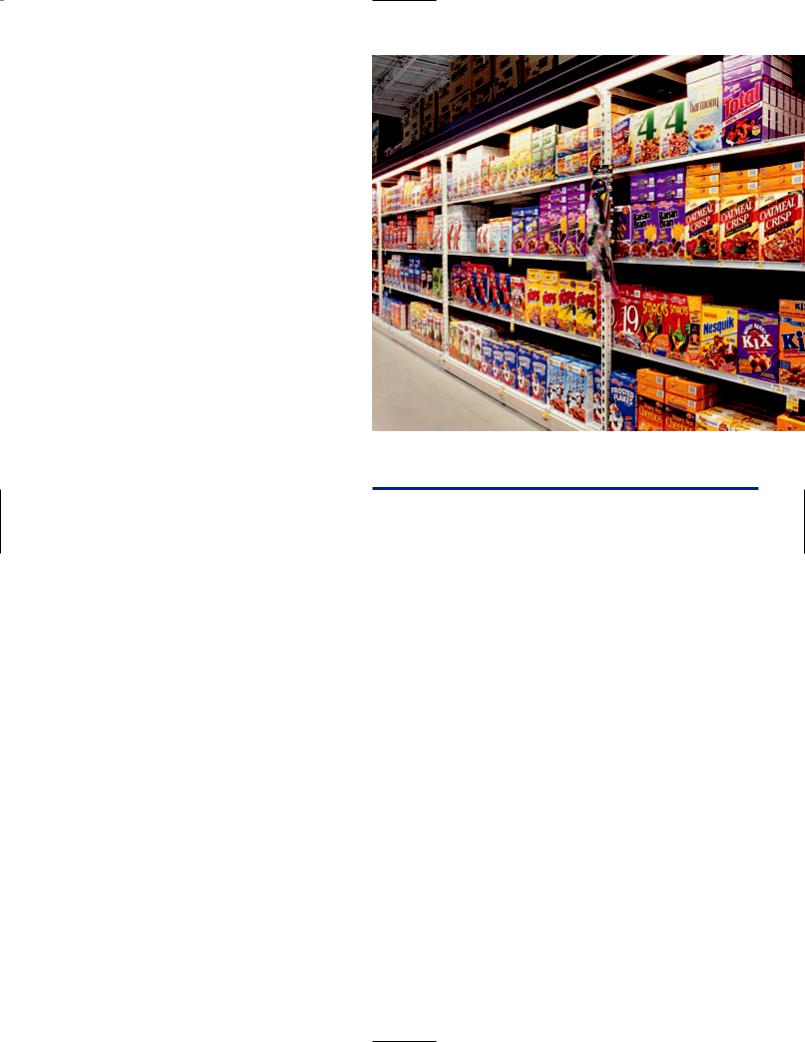
Oligopoly and Interdependence: Looking over Your Shoulder
Oligopoly differs from other market structures in terms of the number of sellers. Both perfectly competitive and monopolistic competitive markets include many sellers, and a monopolistic market has only one seller. Only an oligopolistic market consists of a few sellers.
Will a seller act differently if it is one of only a few sellers than if it is one of many? Some evidence indicates that when a seller is one of only a few sellers, it is more likely to base its behavior on what other sellers do than if it is one of many sellers. Consider the airline market, which is considered to be oligopolistic. If one airline lowers its ticket prices, other airlines are likely to do the same.
Cartels
It is easier for the few sellers in an oligopolistic market to get together and discuss common issues than for the many sellers in either a perfectly competitive or a monopolistic competitive market to do the same. Why would sellers that compete with each other want to get together in the first place? One of the various reasons may be that they want to try to eliminate or reduce the competition they present to one another.
Each year, the three major car companies compete with one another on such things as price, quality, style, and service. Over the years they realized that the competition between them actually helps the car consumer and hurts them. In the boardroom of one of the car companies, the chief executive officer (CEO) says, “Every time our competitors lower prices, we have to do the same thing; every time they come up with a new sport utility vehicle or a better or safer sedan, we have to do the same thing. All this competition is great for the consumer, but it’s not so good for our profits.”
Suppose the CEO calls a meeting with the CEOs at the other two major car companies. They get together for a nice lunch somewhere and talk over their problems. At the end of the lunch they all agree that the com-
The cereal market is an oligopolistic market. Can you name the firms that dominate this market?
petition among them is helpful to consumers but not so helpful to them, so they should try to reduce some of this competition. Specifically, they decide to keep prices where they currently are (no more discounts) and to stop coming up with new car models for the next two years.
The three CEOs have entered into a cartel agreement, an agreement that specifies that they will act in a coordinated way to reduce the competition among them and (they hope) raise their profits. In the United States, cartel agreements are illegal. But suppose that they were not illegal, so nothing prevented the CEOs from making the cartel agreement. What then? Many people would say that the CEOs would be successful at reducing their competition and increasing their profits. In other words, the cartel agreement would harm consumers and help the three car companies.
This answer assumes that the three car companies would actually hold to the cartel agreement. However, firms that enter into cartel agreements often break them. To see why, put yourself in the place of one of the
cartel agreement
An agreement that specifies how the firms that entered into the agreement will act in a coordinated way to reduce the competition among them.
Section 4 An Oligopolistic Market 213
